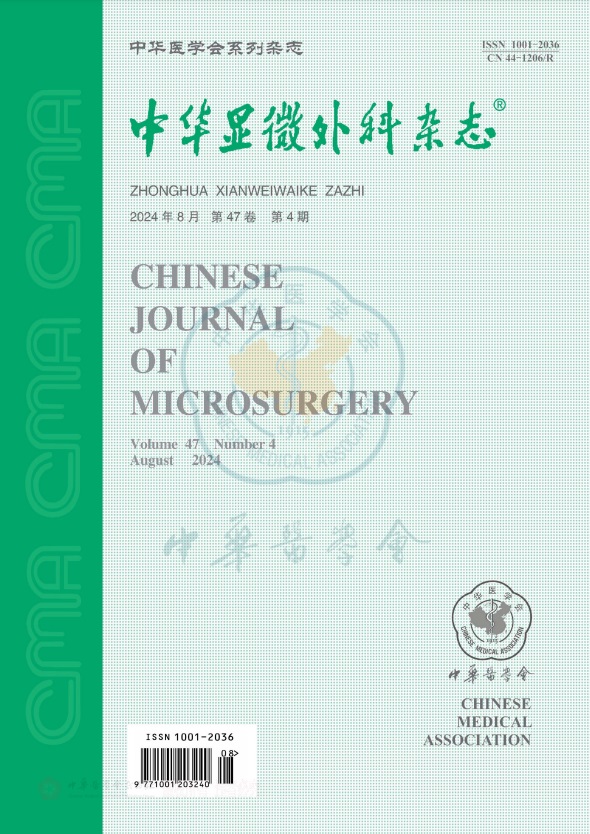Repair of electrical wound injury in upper limbs with perforator flap pedicled with the descending branch of lateral circumflex femoral artery
引用次数: 0
Abstract
Objective To investigate the clinical effect of repairing the electrical wound of upper limbs by using the perforator flap pedicled with the descending branch of lateral circumflex femoral artery. Methods From August, 2014 to July, 2018, the perforator flap pedicled with the descending branch of lateral circumflex femoral artery was used to repair the electrical wound of the upper limbs in 10 cases (11 sides), which were 9 cases (10 sides) in males, 1 case (1 side) in female. Three cases in the left side, 6 cases in the right side, and 1 case in both sides. The area of the flap was 12 cm ×6 cm-26 cm ×11 cm. The arterial, venous and cutaneous nerves of the perforator flap were anastomosed with those of the recipient area, respectively. The patients were followed-up in outpatient depatment, including flap survival, texture, appearance, sensory recovery, donor site healing and scar hyperplasia. Results All the flaps survived without vascular crisis. Infection occurred in 1 case (1 side). The wound was healed 19 d after the operation by using effective antibiotics and dressing change. All cases were followed-up for 4-24 months after the operation. The blood supply of the flaps was good, the texture was similar to that of the recipient area, and the appearance was satisfactory. There was no obvious bloat, and no ulceration of the flap was found. The anterolateral femoral cutaneous nerve was retained in the flap and anastomosed with the cutaneous nerve in the recipient area. The sensory recover to S3 in 3 flaps, S2 in 7 flaps, S1 in 1 flap. The donor site of the flap was sewn up with aesthetic treatment. After the operation, the donor sites presented a linear scar with a concealed position and no occurrence of osteofascial compartment syndrome. Conclusion The perforator flap pedicled with the descending branch of lateral circumflex femoral artery has a constant anatomical position of perforator vessel, a wide excision range, abundant blood supply, a good appearance and a hidden donor site, which is a good choice for repairing the electrical wound. Key words: Electrical injury; Descending branch, lateral circumflex femoral artery; Perforator flap; Upper limb旋股外侧动脉降支蒂穿支皮瓣修复上肢电击伤
目的探讨以旋股外侧动脉降支为蒂的穿支皮瓣修复上肢电击伤的临床效果。方法自2014年8月至2018年7月,采用旋股外侧动脉降支为蒂的穿支皮瓣修复上肢电伤10例(11侧),其中男性9例(10侧),女性1例(1侧)。左侧3例,右侧6例,两侧各1例。皮瓣面积为12cm×6cm~26cm×11cm。穿支皮瓣的动脉、静脉和皮神经分别与受体区吻合。对患者进行门诊随访,包括皮瓣成活率、质地、外观、感觉恢复、供区愈合和瘢痕增生。结果皮瓣全部成活,无血管危象。感染1例(1侧)。术后19天,采用有效的抗生素和换药治疗,伤口愈合。术后随访4~24个月。皮瓣血供良好,质地与受体区相似,外观满意。皮瓣无明显肿胀,无溃疡。股前外侧皮神经保留在皮瓣中,并与受体区皮神经吻合。感觉恢复到S3的3个皮瓣,S2的7个皮瓣,S1的1个皮瓣。皮瓣的供区经美学处理缝合。手术后,供区呈线状瘢痕,位置隐蔽,未发生骨筋膜室综合征。结论以旋股外侧动脉降支为蒂的穿支皮瓣,穿支血管解剖位置固定,切除范围广,血供丰富,外形美观,供区隐蔽,是修复电击伤的良好选择。关键词:触电;下行支,旋股外侧动脉;穿孔皮瓣;上肢
本文章由计算机程序翻译,如有差异,请以英文原文为准。
求助全文
约1分钟内获得全文
求助全文
来源期刊
CiteScore
0.50
自引率
0.00%
发文量
6448
期刊介绍:
Chinese Journal of Microsurgery was established in 1978, the predecessor of which is Microsurgery. Chinese Journal of Microsurgery is now indexed by WPRIM, CNKI, Wanfang Data, CSCD, etc. The impact factor of the journal is 1.731 in 2017, ranking the third among all journal of comprehensive surgery.
The journal covers clinical and basic studies in field of microsurgery. Articles with clinical interest and implications will be given preference.

 求助内容:
求助内容: 应助结果提醒方式:
应助结果提醒方式:


